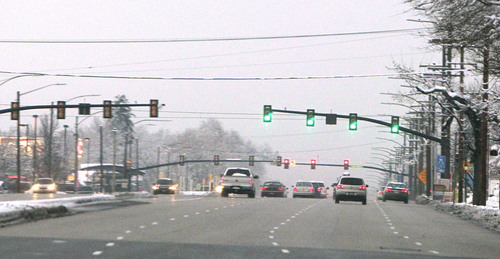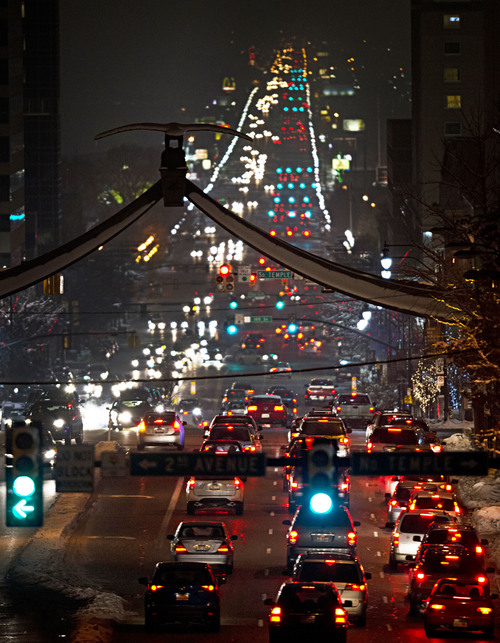This is an archived article that was published on sltrib.com in 2013, and information in the article may be outdated. It is provided only for personal research purposes and may not be reprinted.
Guess what the odds of hitting a red light are on Utah's state highways? Maybe 50-50? Or does it seem closer to 100 percent when in a big hurry?
In November it was just 28 percent, say state highway officials, thanks to the timing of signals aimed at pushing groups of vehicles together through lights that switch to green at just the right moments to keep most of them moving.
Utah has a first-in-the-nation system that is finally taking the guesswork out of how well signals are timed — and it is attracting plenty of visits from out-of-state officials hoping to copy it, and has become a hot topic at national conferences.
"It's revolutionary" in allowing quick discovery and fixes, says Mark Taylor, traffic signal-operations engineer for the Utah Department of Transportation.
The system receives automatic data feeds from about half of the traffic signals on state highways. They use radar or video units on traffic signal arms, or electromagnetic loops in the pavement, to gather and automatically send information about how many cars hit red or green lights, and how fast they approach.
UDOT developed software in-house to help analyze it, using techniques developed by the Indiana Department of Transportation and Purdue University.
"If you can't measure something, you don't know how well you're doing. For years we had traffic-control software that allowed us to make changes to the signal timing, but what we haven't known is how that signal timing affects people," says Rob Clayton, UDOT director of traffic management. "The most common way we would learn about problems was through complaints. That's not ideal. We would like to fix problems before they cause trouble."
So former UDOT Director John Njord challenged the department a couple of years ago to come up with a better system.
What the agency developed "helps us do more with less," Taylor says. "It helps us focus our efforts where they need to be focused instead of just going out there randomly making adjustments."
Clayton says an example of its usefulness came last spring when crews were re-timing signals along Bangerter Highway. To see how well the tweaking worked, they looked at charts the system produced instantly. It showed during off-peak hours, the vast majority of cars approaching the 5400 South intersection were stopped by red lights.
"So they knew immediately that they had a problem," he says, and didn't need to wait for complaints or in-person studies that could take days or weeks. Later charts show they fixed the problem quickly.
The system can also find problems with equipment. For example, data show how often pedestrians hit walk signals at key intersections. It showed that one such signal on 10400 South in Draper was supposedly hit 24 hours a day — and was causing some extra-long waits for cars even in the middle of the night. "That's what upsets people," Clayton says, adding the system led to a fix.
The system generates reports for single intersections or entire highway corridors or even the whole state, and can do it for different periods to measure progress. The data are available to the public online at udottraffic.utah.gov/signalperformancemetrics/.
So which are the best and worst places in the state for traffic signals?
The worst intersection in the state system in November was Bangerter Highway at 4100 South, where 82 percent of traffic hit a red light. Also among the worst was the intersection of Interstate 15 and 800 North in Orem, with 81 percent hitting a red light; Interstate 15 and U.S. 6 in Spanish Fork, 78 percent; and Bangerter and 3500 South in West Valley City, 73 percent.
The best intersection was at the I-15 northbound ramp and 12th Street in Ogden — where zero percent of traffic hit a red light, according to records. Next best was at Redwood Road and 2600 North in Saratoga Springs, 2 percent; and 700 East at 2250 South in Salt Lake City, 4 percent.
For entire corridors, eastbound 10400 South in Salt Lake County was worst with lights stopping 42 percent of traffic on average, followed by southbound Bangerter at 40 percent.
The best major corridors were Pioneer Crossing in Utah County and State Road 36 in Tooele County, both at 15 percent.
Clayton says the system will not only help UDOT move traffic more smoothly over time, but also move more traffic.
"It's apparent to everybody that we can't just widen roads to meet future demands," he says. "We need to gain capacity, and this is an area that will help us improve capacity — and service."





